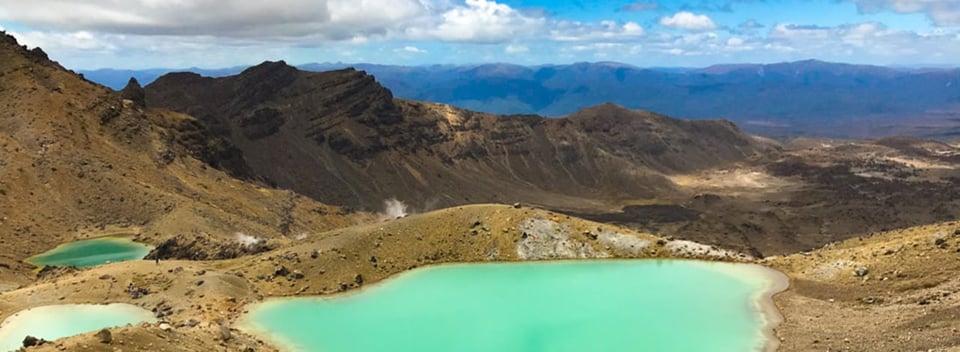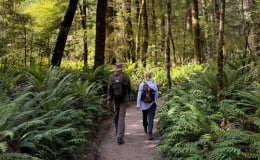
Tongariro Crossing

We tend to label the South Island of New Zealand as the hiker’s paradise and the North Island as its cultural heartland. There is however, one national park in the north that possesses both of these qualities in abundance – Tongariro National Park. Not only is it New Zealand’s oldest national park, it also has UNESCO dual World Heritage status. Praised for both its natural and cultural significance, it was actually the first place in the world to receive cultural World Heritage status!
Tongariro National Park is home to the Tongariro Alpine Crossing, dubbed ‘the best day hike in the world’. It is one of the highlights of our Sweet North trip and it is a truly unique and magical place where legends and myths come to life.

Exploring Tongariro National Park feels otherwordly.
Fun facts about the Tongariro Alpine Crossing
-
Tongariro National Park is also home to the active volcano Mt Ngauruhoe, or if you are a Lord of the Rings fan, perhaps you might know it better as Mount Doom!
-
Multiple eruptions began forming this landmass over 275,000 years ago.
-
Tongariro National Park is an extreme landscape that experiences dramatic changes, so the flora and fauna of the area needs to be resilient if it is going to survive here! Red tussock make up the majority of the flora on the upper slopes and the native pipit bird can be found nesting in its branches. Totara trees dominate the lower levels. The endangered whio/blue duck and the North Island brown kiwi also call this national park home.
-
In summer, you’ll see a variety of alpine plants in bloom, including the purple parahebe, mountain daisies, buttercups and eyebrights.
-
Tongariro National Park was awarded World Heritage status in September 1887. The paramount chief of the Maori tribe Ngati Tuwharetoa, Te Heuheu Tukino IV gifted the land to the New Zealand Government in order to protect and preserve this sacred place.

The Tongariro Alpine Crossing is one of the best day hikes in the world.
Hiking the Tongariro Alpine Crossing
The most well-known Tongariro National Park hike is the Tongariro Crossing. It is a one-way hike that stretches for 19.4 km (12 miles) taking in the very best views of the active volcanoes Mt Tongariro and Mt Ngauruhoe. The starting point is the Mangatepopo carpark and the end point is Ketetahi carpark. It’s a well-marked track that takes in stunning scenery and hotspots like Soda Springs, Red Crater (the highest point on your walk), Emerald Lake and Blue Lake. It’s an intermediate level hike with nothing technical to it and can be achieved by most active people with a can-do attitude! This otherworldly hike usually takes just under eight hours to complete.
Starting from Mangatepopo Road, the first leg of your journey takes you up to Soda Springs. You’ll follow the Mangatepopo Stream around the edge of an old lava flow. From Soda Springs, you’ll climb Devil's Staircase, a challenging ascent from 1,400 to 1,600 metres (4,593 to 5,249 feet) above sea level. Make sure to look up from your feet to see if you can spot the mesmerising volcanic cone of Mt Taranaki in the distance.
You’ll follow a ridgeline from South Crater to Red Crater and on towards Blue Lake. As you hike, feast your eyes on the old lava flow, the striking Emerald Lake and the steam rising off the land. When you reach Ketetahi Shelter, you’ll be rewarded with superb views of Mt Pihanga, Lake Rotoaira and Lake Taupo before starting your descent down to the carpark.
The Tongariro Alpine Crossing is part of one of New Zealand’s Great Walks, the Tongariro Northern Circuit. This is a 43.1 km (26.8 miles) looped walk that will take you three to four days to complete. You will fall in love with this ethereal place, which morphs from alpine forest into a surreal and seemingly barren plateau.
Tongariro weather
From the sparse red and brown lands of the region in summer to the white snow-covered peaks in winter, the area is always spectacular no matter the season. Tongariro Crossing weather can be fickle, therefore the best time of year to do the Tongariro Crossing is in summer. Unless you are skilled with an ice axe, crampons and navigation, we do not recommend taking on this challenge in winter. If you’re not a seasoned hiker, hire a guide for the day, or better yet, join us on our Sweet North, where your very own guide will take you along this incredible crossing.

When Tongariro weather is ideal – hiking the Tongariro Crossing on a bluebird day!
Tips to hike the Tongariro Alpine Crossing
Tongariro Crossing: Transport
Because the Tongariro Crossing is a one way track, you will need to organise transportation to and from the start and end points. If you plan to do the entire hike during the peak season (October through to April), there is a four-hour time restriction in place at the Mangatepopo Road end, so you’ll need to book on to a Tongariro Alpine Crossing shuttle or arrange a drop off and pick up. There are plenty of shuttle services operating from Taupo, Turangi, National Park Village, Whakapapa Village and Ohakune.
If you are travelling with us on our Sweet North tour, your driver will drop you off with your guide at the start of the hike and will pick you up at the other side. When you come with us there is no need to worry about any of the logistics!
Tongariro Crossing: What to pack
When hiking in New Zealand, there are a few essential pieces of kit that you should always have with you. On top of choosing the right clothing and footwear, you should add your lunch, plenty of snacks and at least 1.5 litres of water to your daypack. Sunscreen, insect repellent, a first aid kit, map and your mobile phone are also essentials that you should carry on any hiking adventure.
Doing your Tongariro National Park hike with New Zealand Trails
On day four of our Sweet North tour, you will hike the world-renowned Tongariro Alpine Crossing. This 19.4 km volcanic crossing is set high on the central plateau amongst three active volcanoes, the scenery is more akin to surrealist art than real life. With red rocks, deep emerald lakes, steam rising from craters, and the unmistakable cone-shaped mountains, it's as if you’ve stepped back in time, or possibly onto another planet.
If you want to find out more about the incredible 5-14 day hiking tours we run in New Zealand, you can request a free copy of our brochure here.







